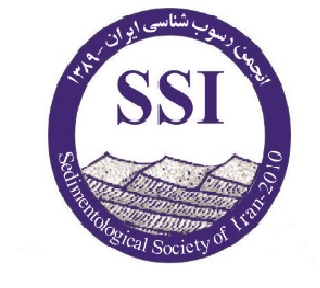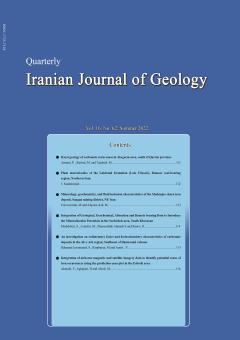Mineralogy, geochemistry, and fluid inclusion characteristics of the Madanjoo skarn iron deposit, Sangan mining district, NE Iran
Subject Areas :M. Fotovat Jami 1 , Masoud Alipour-Asll 2
1 -
2 -
Keywords: Magnesian iron skarn, Geochemistry, Mineralogy, Madanjoo, fluid inclusion, Sangan mining district,
Abstract :
The Madanjoo prospect is one of the eastern anomalies in the Sangan mining district. This area is located in the eastern part of the Cenozoic Alborz volcanic-plutonic arc. The geology of the area includes Jurassic shaly sandstone, lime mudstone, and sandstone, Upper Cretaceous limestone and dolomitic limestone, and Upper Eocene tuff and lava flow sequences, Middle Eocene skarn rocks, and Quaternary sediments. The most important occurrence in the Madanjoo area is the penetration of ferrous fluids into terrigenous and carbonate formations, skarnization, and iron mineralization, which is characterized by the presence of magnetite and calcsilicates minerals. based on type and frequency of calcsilicates, The skarn zones include olivine-pyroxene-garnet skarn, garnet-pyroxene skarn, garnet skarn, pyroxene-wollastonite-magnetite skarn, magnetite skarn, phlogopite skarn, tremolite-actinolite skarn, and epidote skarn. Iron mineralization occurred as massive, banded, vein-veinlets, breccia, and disseminated forms mostly in the Upper Cretaceous limestone and dolomite rocks and along NE-SW fault zone trend. Magnetite is the main ore mineral accompanied with pyrite, chalcopyrite, pyrrhotite, and secondary iron minerals. The composition of the Madanjoo garnet, pyroxene, and olivine are andradite-grossular (mostly andradite), diopside-hedenbergite (mostly diopside), and forsterite, respectively. Thermobarometry study based on pyroxene chemistry show that pyroxenes crystallized in temperature range of 458-689 °C, pressure of 2.21 kb, and depth range of 1-2.5 km. Three main paragenetic stages of skarn formation and ore deposition were recognized in the Madanjoo deposit: (1) a prograde stage developed with prograde garnet and pyroxene forming at 330° to 410 °C with a fluid salinity between 33 to 58 wt.% NaCl equivalent, (2) a retrograde garnet, tremolite- actinolite, and calcite which formed at 120° to 300 °C with fluid salinity of 16 to 49 wt.% NaCl equivalent, and (3) a post-ore stage with calcite and minor quartz veins that developed at 95° to 190 °C with salinity range of 2 to 15 wt.% NaCl equivalent. Possible iron ore formation mechanisms include: fluid mixing, boiling, and dilution with meteoric waters along with decreasing temperature. Finally, the Madanjoo iron mineralization is introduced as a magnesian exoskarn iron deposit.
تقی پور، ب. و بذرافشان، آ.، 1394. سنگشناسی و زمینشیمی کمپلکس ماگمایی-دگرگونی توتک و تعیین منشا کانسنگ آهن عنبر کوه استان فارس. فصلنامه زمینشناسی ایران، 9، 34، 85-102.
- رحمانی جوانمرد، س.، طهماسبی، ز.، دینگ، ز. و احمدی خلجی، ا.، 1399. بررسی رفتار زمینشیمیایی عناصر اصلی و کمیاب خاکی در گارنتهای موجود در سنگهای دگرگونی پهنه بروجرد (پهنه سنندج-سیرجان). فصلنامه زمینشناسی ایران، 14، 53، 87-107.
- سربوزی حسینآبادی، آ.، بومری، م. و گلمحمدی، ع.، 1399. مطالعه کانهزائی آهن بغلبید با استفاده از شواهد زمینشناسی، کانیشناسی و ژئوشیمی، سنگان خواف در شمالخاوری ایران. فصلنامه زمینشناسی ایران، 14، 54، 54-37.
- فتوت جامی، م.، 1398. کاني¬شناسي، دگرساني، ژئوشیمي و الگوی پیدایش کانسار آهن معدن¬جو، آنومالی شرقی معدن سنگ¬آهن سنگان، جنوب¬شرقی خواف. پایان¬نامه کارشناسی ارشد، دانشگاه صنعتی شاهرود، 302.
- گل-محمدی، ع.، مظاهری، س.ا.، ملک¬زاده شفارودی، آ. و کریم¬پور، م.ح.، 1393. سن¬سنجی زیرکن با روش U-Pb و ژئوشیمی توده¬های گرانیتی سرخر و برمانی شرق معدن سنگ¬آهن سنگان خواف. مجله پترولوژی، 5، 17، 83-102.
- مظهری، ن.، ملك زاده شفارودي، آ. و قادری، م.، 1395. ژئوشیمی تودههای نفوذی، سنگشناسی اسکارن، کانیشناسی و شیمی ماده معدنی در آنومالی سنجدک I، خاور مجموعه معدنی سنگان خواف. فصلنامه علوم زمین، 25، 100، 246-235.
- Aydin, F., Thompson, R.M., Karsli, O., Uchida, H., Burt, J.B. and Downs, R.T., 2009. C2/c pyroxene phenocrysts from three potassic series in the Neogene alkaline volcanics, NE Turkey: their crystal chemistry with petrogenetic significance as an indicator of P–T conditions. Contribution in Mineralogy and Petrology, 158 (1), 131-147.
- Barnes, H.L., 1997. Geochemistry of hydrothermal ore deposits. 3rd Edition, New York, John Wiley and Sons, 992.
Beane, R.E., 1983. The Magmatic–meteoric transition. Geothermal Resources Council, Special Report, 13, 245–253.
- Deer, W.A., Howie, R.A. and Zussman, J., 1996. An introduction to the rock-forming minerals. 2 ed. Hong Kong, Longman, 695.
- Drummond, S.E. and Ohmoto, H., 1985. Chemical evolution and mineral deposition in boiling hydrothermal systems. Economic Geology, 80, 126–147.
- Dupuis, C. and Beaudoin, G., 2011. Discriminant diagrams for iron oxide trace element fingerprinting of mineral deposit types. Mineralium Deposita, 46(4), 319–335.
- Driesner, T. and Heinrich, C.A., 2007. The system H2O-NaCl. Part I: Correlation formulae for phase relations in temperature-pressure-composition space from 0 to 1000 °C, 0 to 5000 bars, and 0 to 1X NaCl. Geochimica et Cosmochimica Acta, 71(20), 4880–4901.
- Einaudi, M., Meinert, L.D. and Newberry, R.J., 1981. Skarn deposits. Economic Geology, 75th Anniversary Volume, 317–391.
- Golmohammadi, A., Karimpour, M.H., Malekzadeh Shafaroudi, A. and Mazaheri, S.A., 2015. Alteration-mineralization, and radiometric ages of the source pluton at the Sangan iron skarn deposit, northeastern Iran. Ore Geology Reviews, 65(2), 545-563.
- Groat, L.A., Turner, D.J. and Evans, R.J., 2014. Gem Deposits. In Treatise on Geochemistry, 2nd ed.; Holland, H.D., Ed.; Elsevier: Amsterdam, The Netherlands, 13, 595–622.
- Haas, J.L., 1971. The effect of salinity on the maximum thermal gradient of a hydrothermal system at hydrostatic pressure. Economic Geology, 66 (6), 940-946.
- John, D.A., Ayuso, R.A., Barton, M.D., Blakely, R.J., Bodnar, R.J., Dilles, J.H., Gray, Floyd, Graybeal, F.T., Mars, J.C., McPhee, D.K., Seal, R.R., Taylor, R.D. and Vikre, P.G., 2010. Porphyry copper deposit model, chap. B of Mineral deposit models for resource assessment. U.S. Geological Survey Scientific Investigations Report, 5070–B, 169.
- Mehrabi, B., Ghasemi Siani, M., Zhang, R., Neubauer, F., Lentz, D.R., Tale Fazel, E. and Karimi Shahraki, B., 2021. Mineralogy, petrochronology, geochemistry, and fluid inclusion characteristics of the Dardvay skarn iron deposit, Sangan mining district, NE Iran. Ore Geology Reviews, 134, 104146.
- Meinert, L.D., Dipple, G.M. and Nicolescu, S., 2005. World Skarn Deposits. Economic Geology 100th Anniversary: Littleton, CO, USA, Volume 299–336.
- Meinert, L.D., 1992. Skarns and skarn deposits. Geoscience Canada, 19 (4), 145–162.
- Nimis, P. and Taylor, W.R., 2000. Single clinopyroxene thermobarometry for garnet peridotites. Part 1 Calibration and testing of a Cr-in-cpx barometer and an enstatite-incpx thermometer. Contribution in Mineralogy and Petrology, 139, 541-554.
- Putirka, K.D., 2008. Thermometers and barometers for volcanic systems, in: Minerals, inclusions and volcanic processes, edited by: Putrika, K. and Tepley, F. Review in Mineralogy and Geochemistry, 69, 61-120.
- Shepherd, T.J., Rankin, A.H. and Alderton, D.H.M., 1985. A practical guide to fluid inclusion studies. Blackie, Glasgow, 239.
- Stӧcklin, J., 1968. Structural history and tectonics of Iran: a review. American Association of Petroleum Geologists Bulletin, 52 (7), 1229–1258.
- Whitney, D.L. and Evans B.W., 2010. Abbreviations Sheferd et al., for names of rock-forming minerals. American Mineralogist, 95, 185-187.
- Wilkinson, J.J., 2001. Fluid inclusions in hydrothermal ore deposits. Lithos, 55(1-4), 229- 272.
- Yavuz, F., 2013. WinPyrox: A Windows program for pyroxene calculation classification and thermobarometry. American Mineralogist, 98(7), 1338-1359.

